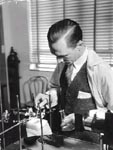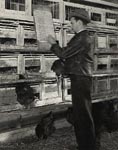|  | "Pan America", the first fusarium wilt resistant tomato, is released.
Glanders, a horse disease caused by bacteria that attacks the mucus membrane in the nostrils and glands of the lower jaw and is transmittable to humans, is eliminated. |
 |  | National Youth Administration's Youth Resident Project established at Beltsville to give young men practical experience in the mechanical shops and laboratories. These men are housed in buildings 413-425. |
 |  | Scientists play a significant role in World War II: 2,4-D is developed as a selective herbicide. It remains one of the most effective and safest broad leaf herbicides available and is one of the major components of today's lawn herbicides. Mildew- and rot-proof fabrics and bandages are developed. |
 |  | Improved methods for dehydrating meat for lend.lease and military use are invented. Developed the use of vermiculite as a soil-less medium for producing fresh produce where suitable soil is unavailable. The first daily human nutrition guide is published which is used to develop the military K-rations. |
 |  | A new group of pesticides safer for humans--DEET, DDT, Rotenone, Allethrin--is developed. The aerosol spray application method is also developed. This research helps keep soldiers safe from ticks, mosquitoes, chiggers, and fleas and the diseases they can spread. An airport is constructed on Beltsville property for military use. |
 |  | Biological Survey Division of USDA transferred in 1940 to the Department of Interior. With this transfer, 2,238 acres are given to the Department of Interior to establish the Patuxent Wildlife Refuge.
Researchers develop poultry diets that cut the amount of feed needed to produce a 2.5 pound broiler from 20 pounds to only 9 pounds. |
 |  | The first of 454 Glenn Dale azalea varieties is released to the public.
Additional land acquisition and construction occurs. 1,661 new acres are acquired, resulting in a total of 14,332 acres. Over 20 buildings and greenhouses are constructed. |








